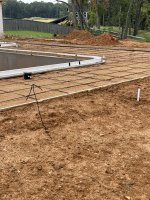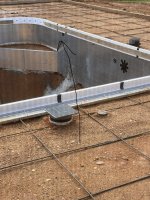- Nov 15, 2021
- 23
- Pool Size
- 23800
- Surface
- Vinyl
- Chlorine
- Salt Water Generator
- SWG Type
- Pentair Intellichlor IC-40
I’m getting a pentair autofill installed with my new build. Water supply will be hooked up during lawn/irrigation system repair at the capped pvc pipe. the arrow in the first pic points to the overflow fitting. Builder stated it won’t be needed since overflow drain is built into the pool (the arrow in the second pic). It will drain out a pipe downslope from the pool which is at the top of a hill with more grass and then a retention pond at the bottom.
.
I want to be able to leave town for a week and not worry about water level (too high/low for skimmers, deck flooding) and just keep the same pool pump schedule.
.
I reviewed the equipment install instructions and you can adjust the float to a desired water level. If water exceeds level, it will drain out the overflow, but not if it’s capped. I suppose this won’t matter if the sidewall pool overflow drain (2nd pic) is placed in the sweet spot to keep water flowing at the right height to the skimmers.
.
Is there any situation that I might need the autofill overflow pipe instead of or in addition to the sidewall overflow drain?
My builder and his crew have been great and communication has been one of their best attributes, so this post is more to help my own understanding. Thank you for any information you can provide.


.
I want to be able to leave town for a week and not worry about water level (too high/low for skimmers, deck flooding) and just keep the same pool pump schedule.
.
I reviewed the equipment install instructions and you can adjust the float to a desired water level. If water exceeds level, it will drain out the overflow, but not if it’s capped. I suppose this won’t matter if the sidewall pool overflow drain (2nd pic) is placed in the sweet spot to keep water flowing at the right height to the skimmers.
.
Is there any situation that I might need the autofill overflow pipe instead of or in addition to the sidewall overflow drain?
My builder and his crew have been great and communication has been one of their best attributes, so this post is more to help my own understanding. Thank you for any information you can provide.



